How would I talk about the capabilities of the Intel Z68 Express chipset using the example of MSI Z68A-GD80 (B3)
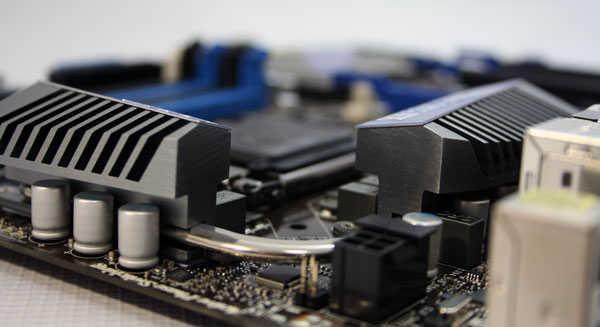
On behalf of a trained user, I propose to get acquainted with the capabilities of the new chipset from the guys from Santa Clara using the example of the flagship MSI Z68A-GD80 (B3) motherboard. Of course, I know in advance what I have to face: overclocking of the processor and integrated graphics, Intel RST SSD Caching (Rapid Storage Technology) technology and, of course, a unique initiative of LucidLogix Virtu.
But for a start, a little old-time grumbling. I have only one question for Intel: “Why was it impossible to immediately release the logic of the Z68 Express?”. After the announcement of the LGA 1155 platform, many who wished to switch to it had to make a choice between two sets of Intel P67 and Intel H67 system logic. The first one provided all the necessary tools for overclocking Core 2500K / 2600K processors and RAM. The second one opened access due to the FDI (Flexible Display Interface) bus to a fairly powerful GMA HD 3000/2000 graphics core with its proprietary Intel Quick Sync Video chip, which at the hardware level speeds up the transcoding of video in MPEG-2 and H.264 formats. In addition, thanks to technology Intel InTru 3D integrated graphics allows you to display stereoscopic video in 3D Blu-ray format via HDMI 1.4. Either the processor overclocking, or the presence of integrated graphics - did not give another.
')
I suggest using a simple example to illustrate the words spoken above. So, there is a processor Core i7-2600K (3.4 GHz), which easily conquers 4,700 MHz with air cooling. There is a person who wants to get quick feedback from his PC on his actions, who is interested in driving movies to the format of his beloved iPad, sometimes this user has a desire to run in CS with friends. For all this, it has enough computing reserves of the Core i7-2600K model. In addition, the future owner of the LGA 1155 platform is familiar with the concept of overclocking, for this reason he looks at the Core 2500K / 2600K chips with the letter “K” in the title.
On the Intel P67 platform, it is not able to get the following benefits from the GMA HD 3000/2000.
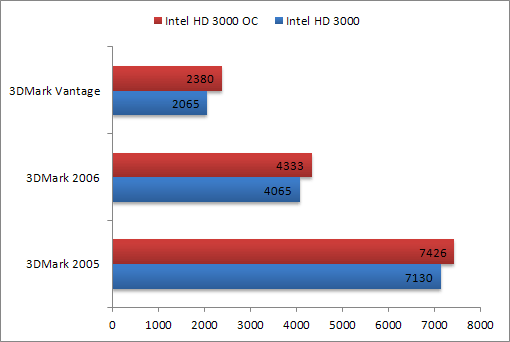
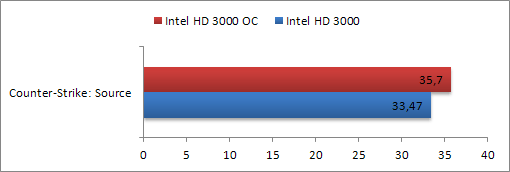
The Intel H67 platform makes it impossible to get an additional 1,300 MHz for the Core i7-2600K processor cores.

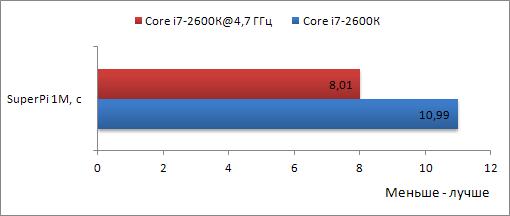
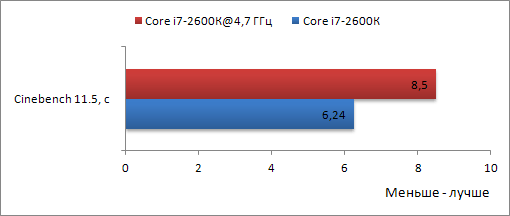

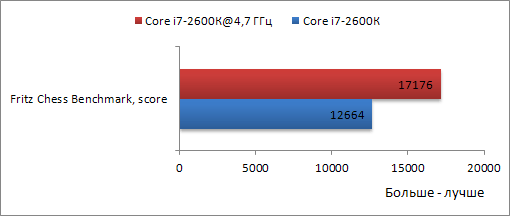
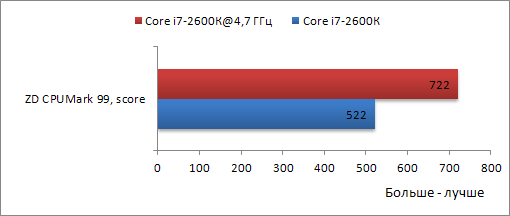
Moreover, when choosing a motherboard based on the Intel P67 logic, the user is deprived of the opportunity to save on a discrete graphics adapter. Even for a budget video card, you need to give about $ 35, and in fact this money can be spent on the purchase of a more efficient cooler for the processor or on the purchase of another 4 GB of RAM. When choosing the Intel H67, we will remain without overclocking the processor, and we simply will not buy the Core i7-2600K model, but we will manage with a solution without a “K”. All the shortcomings of the Intel P67 and Intel H67 chipsets when handling the Core i7-2600K are designed to solve the Intel Z68 Express.
Motherboard MSI Z68A-GD80 (B3).
First of all, I want to list the fact that when meeting with the new motherboard based on the logic of Intel Z68 Express for most users it is important and what is not. In other words, it’s not what’s important, according to the marketing department of a company that manufactures motherboards.
What matters:
- Convenient tools for overclocking both in the BIOS and in the environment of the Windows operating system;
- Good built-in sound;
- Trouble-free operation of the technology LucidLogix Virtu;
- USB 3.0;
- Multiphase power system. Maybe not so important, but still I want to provide my processor with good power;
- Quality element base;
- CrossFireX and SLI configuration support. Many people know in advance that they will never buy two video cards, but just in case we leave this item.
- Intel RST SSD Caching. Perhaps, on this point there are a lot of doubts. Yet users prefer to control what they want to place on the SSD.
- The presence of two network interfaces. A very useful option, sometimes helping out.
- The presence of the connector IDE. Still, the fleet of optical drives and ATA hard drives is great.
- The presence of PS / 2 connectors or the presence of the combined.
- Form factor motherboard.
- Number of PCI slots;
What does not matter:
- The number of USB ports;
- The number of ports SATA 3 Gb / s and SATA 6 Gb / s;
- The presence of optical S / PDIF;
- Power and reset buttons. Only overclockers who use them endlessly will appreciate such a solution.
Equipment
The MSI Z68A-GD80 (B3) motherboard comes in a large and colorful package, on all sides of which the technical specifications of the product and the technologies used are MSI.
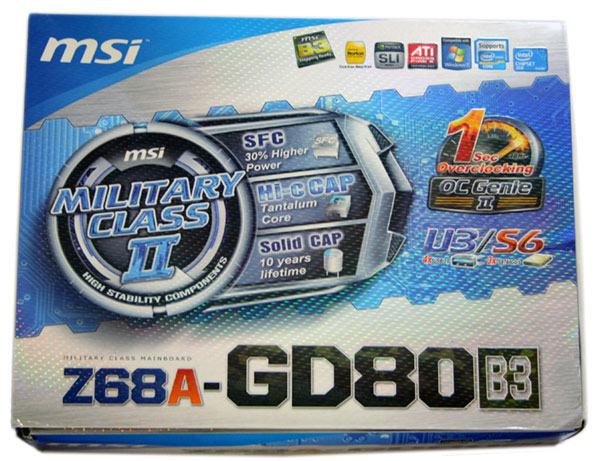

Like a laptop, the top of the box is folded back, hiding even more useful information.
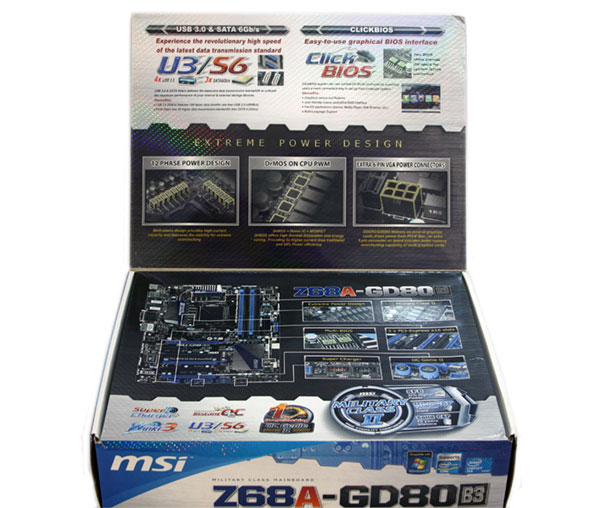
Contents of delivery:
- 4 cables SATA SATA 6Gb / s;
- 2 adapters for powering on SATA;
- SLI bridge;
- Rear panel cap;
- V-Check voltage adapters with
multimeter; - Panel with two USB 3.0 connectors;
- M-connectors adapter kit;
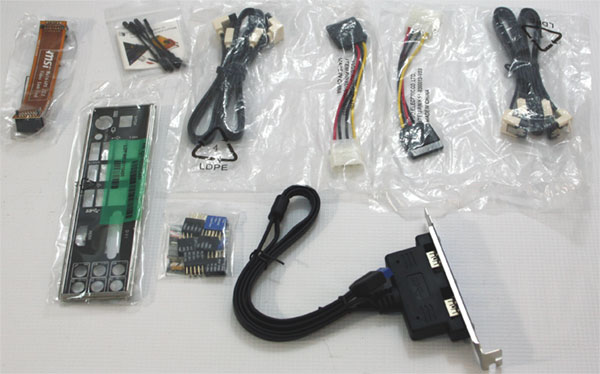
But for the additional panel with two USB 3.0 connectors thanks.

From the literature you can find the following.

Appearance
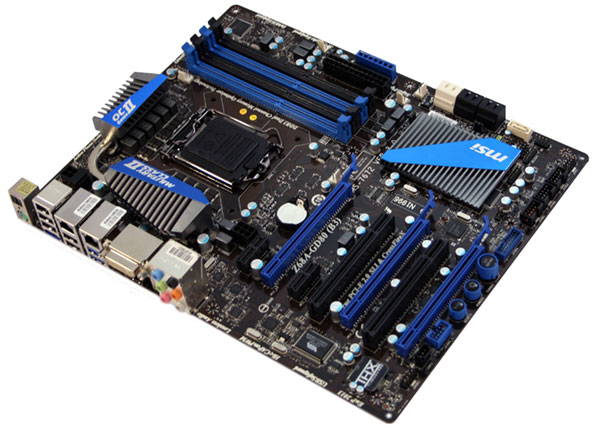

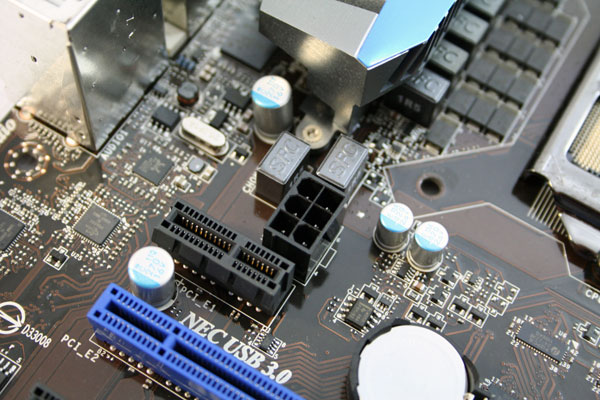
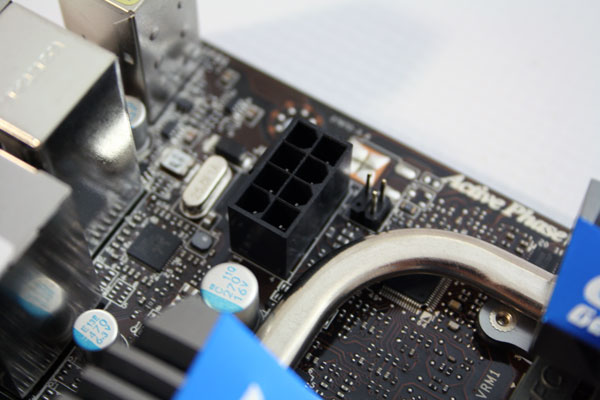

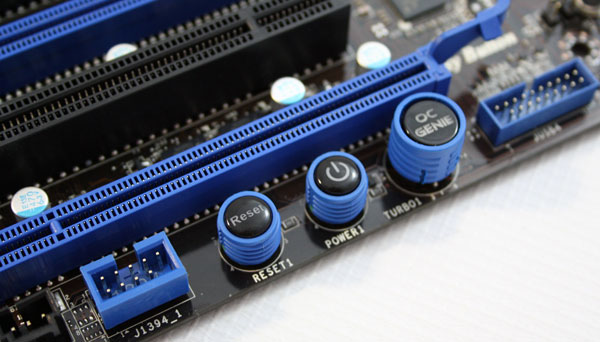
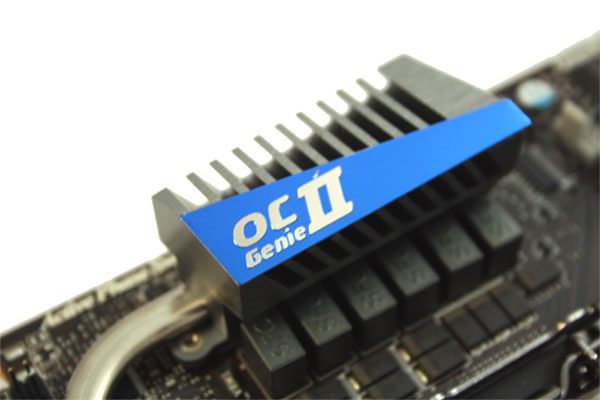
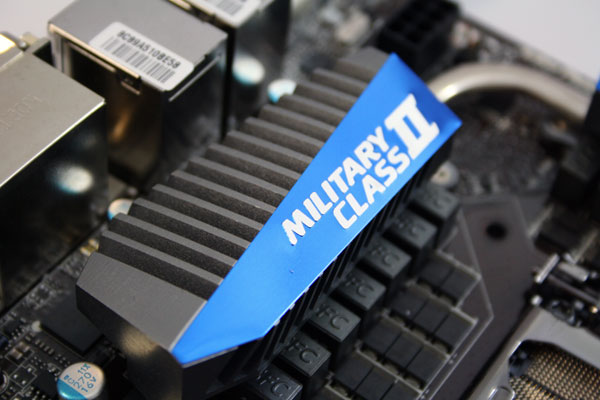
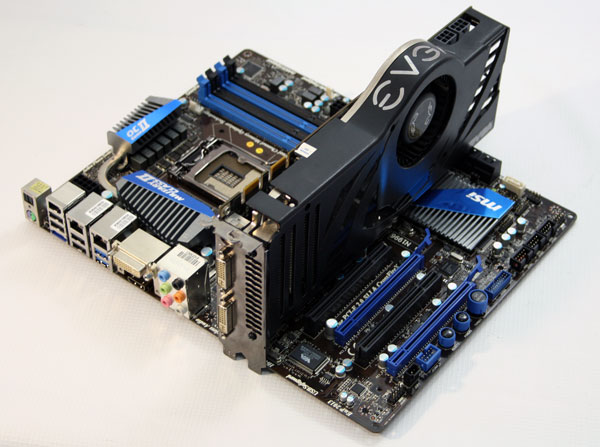
Specifications
I will not bore the reader with a long list of all the controllers, technologies, and other elements of the MSI Z68A-GD80 (B3) motherboard, along with a good dozen advisory pictures. I will give a summary table with the characteristics of this flagship product.

Overclocking
Before you provide the reader with a few screenshots of the results of overclocking, both in manual mode and using OC Genie II technology, you should say a few words about the concept of overclocking as part of the LGA 1155 platform. This concept boils down to one thing: you have a Core 2500K processor / 2600K or not. If there is, then by increasing the multiplier and increasing the operating voltages, you can overclock the chip to an impressive 5.0 GHz using air cooling. If not, you will have to be content with a modest additional 5-6 MHz at the base frequency. In other words, the Core i7-2600 model (without the “K” letter) with its 34x multiplier will be able to overclock from the nominal frequency of 3400 MHz to only 3570 MHz if the BCLK is 105 MHz. Why is that? The desire to simplify the PCB layout of LGA 1155 motherboards made Intel move the base frequency generator to the chipset. Yes, the same clocker is now in the chipset. Now with increasing BCLK frequency, working frequencies of other PC components also increase. For example, the same SATA controller is allergic to higher frequencies of its operation. Therefore, there is nothing surprising about the fact that all motherboards, which are based on the Intel P67 chipset, and which are on the Intel Z68 chipset, have a threshold for increasing the reference frequency between 105-108 MHz.
The motherboard was able to show stability at a BCLK frequency of 105 MHz. And there is no fault at all with the MSI engineer.

The technology of automatic overclocking of OC Genie 2, which allows using a special button to overclock the processor and memory in one touch, forced the Core i7-2600K to operate at 4200 MHz, and the memory in DDR3-2133 mode.
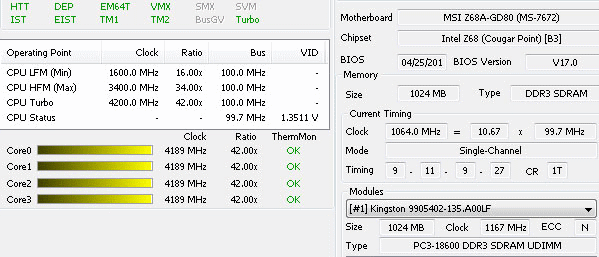
There were no surprises in the manual mode due to the fact that the Zalman CNPS 9700 cooler was not the most productive by modern standards. It was he who limited the overclocking potential of the MSI Z68A-GD80 (B3) board. As the voltage rises, the heat output from the processor grows exponentially, and Zalman 9700 cannot cope with its removal no matter what motherboard it is. But extreme cooling systems would significantly increase the voltage applied to the processor, thereby increasing overclocking. As a result, a completely standard operating frequency of 4,700 MHz was obtained.
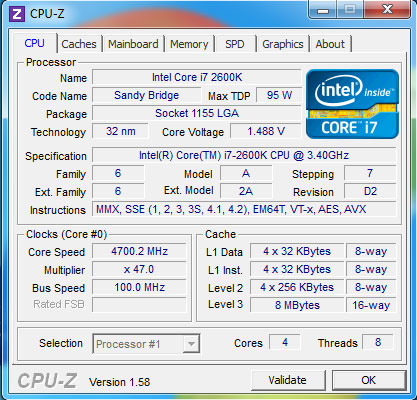
LucidLogix Virtu Technology
Immediately touch the problem. Yes, the Intel Z68 Express chipset allows you to use both the advantages of the Intel P67 and Intel H67 logic. The owner of the motherboard based on Intel Z68 is able to access the integrated graphics and overclocking the Core 2500K / 2600K processors. Even more, he has access to a special GPU graphics unit GMA HD 3000/2000 called Intel Quick Sync Video, which accelerates the transcoding of video files. But this is not a problem, it is worthwhile to install a discrete video card, as the integrated graphics chip in the Sandy Bridge processor is automatically turned off. This makes it impossible to use the benefits paid by the user. LucidLogix offered its solution to this issue - Virtu.
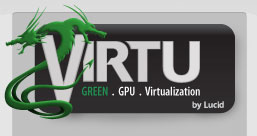
If you approach the description of this technology without fanaticism, then you can keep within one sentence. The LucidLogix Virtu initiative allows you to use the integrated Intel GMA HD 3000/2000 core in 2D mode, and when the PC switches to 3D mode, automatically switch to discrete graphics. The advantages are obvious: reducing the power consumption of the system due to the lack of load on the discrete graphics card and access to the Quick Sync Video technology.
The well-coordinated work of the LucidLogix Virtu technology within the Intel Z68 Express chipset and discrete graphics is provided by the following requirements:
- The presence of the operating system Windows 7;
- Connecting the monitor to the video output of the motherboard;
- The BIOS settings should indicate that the initialization of the graphics subsystem of the PC must begin with integrated graphics;
- The Virtu driver is installed.
In the main tab of the Virtu control panel is not difficult to understand and it does not require further clarification.

The second tab displays information about supported games and benchmarks. Updating Virtu drivers brings not only the optimization of the technology from LucidLogix, but also support for new games.
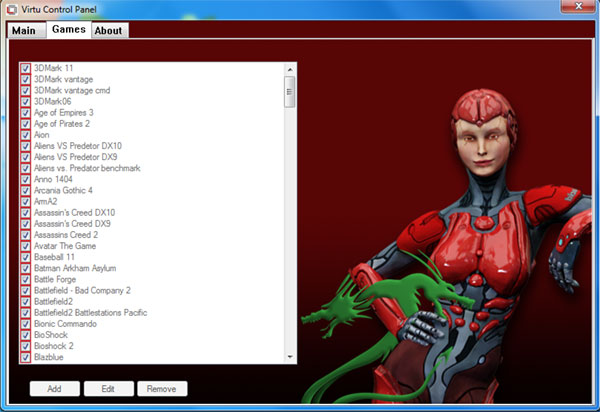
If the software product is supported by the Virtu driver, a corresponding notification will appear on the screen. Yes, and the number of FPS is easy to understand. Of course, the LucidLogix Virtu logo can be disabled.
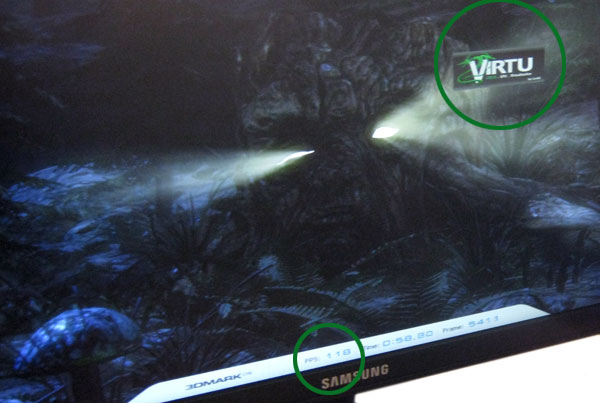
Considering that the operation of the integrated graphics and the discrete video card is controlled through the Lucid Multi GPU virtual driver, it is worth knowing how much this driver “bites off” the performance of the discrete accelerator. To do this, add the N580GTX Lightning video card to the test bench and run through several of the most popular benchmarks in and with Virtu modes of operation.

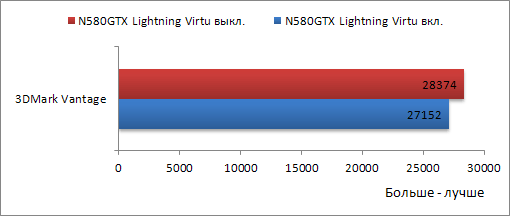
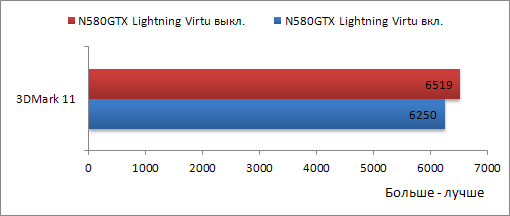
Performance losses amounted to about 4-5%, which can easily be compensated by overclocking a video card. If we have lost somewhere, we must add it somewhere. And you can add in the conversion of videos from one format to another. We will use the program Badaboom 2.0 to provide the Intel Quick Sync Video unit with a job. To enable the Quick Sync Video features, you need to tick off the “Graphics Acceleration” item in the program settings.
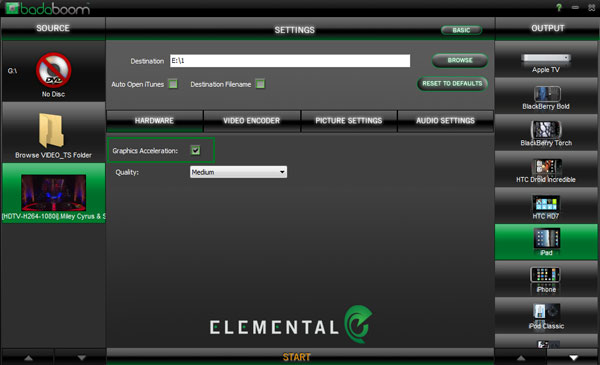
Even with the naked eye, you can notice the difference between decoding a movie using the processor cores and the Intel Quick Sync Video block.

The test results will display in graph format. For clarity, let's add results with the Core i7-2600K processor overclocked to 4.7 GHz, as well as the built-in GMA HD 3000 GPU from 1350 MHz to 1550 MHz overclocked to the core.

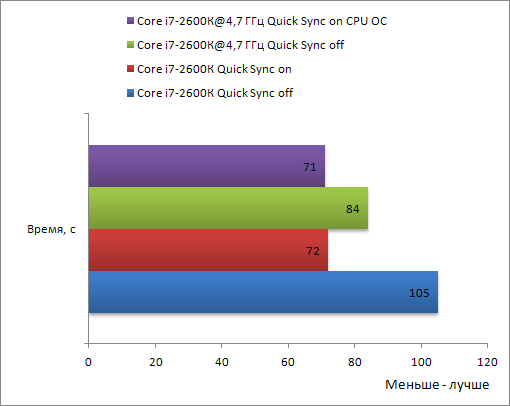
Activating Intel Quick Sync Video technology gives you an additional 45% performance. In other words, with the conversion of video for iPad format, the Core i7-2600K handled in 105 seconds, and with acceleration enabled in just 72 seconds. The overclocking of the Core i7-2600K chip had a positive effect on the transcoding speed, but it still failed to reach the result of the Quick Sync Video block. The Media Acceleration Unit began to work a bit faster, when the GMA HD 3000 overclocked.
Intel RST SSD Caching Intelligent Caching
Mechanics can not keep up with the electronics in matters of speed. This statement is extremely true for drives on magnetic plates and solid-state drives. Hard drives, with their huge volume and relative affordability, lose in terms of performance to less capacious and more expensive SSDs. If you want a quick load of the operating system and a number of resource-intensive programs, buy a "hard-core", but lose in volume. If you want volume - lose in speed or empty your wallet. Intel RST SSD Caching (Rapid Storage Technology) is capable of combining the positive aspects of HDD and SSD to some extent. This Intel initiative can teach SSD to become an intelligent assistant for a hard disk.
In order to properly assemble the PC disk subsystem within the RST SSD Caching technology, it is necessary to meet a number of requirements:
- Of course, only the platform LGA 1155 based on Intel Z68;
- Only Core i3, Core i5 or Core i7 processors in the LGA 1155;
- SATA operation mode must be set as SATA RAID;
- The installed operating system is Windows Vista or Windows 7 in SATA RAID mode;
- Only one SSD drive and no more than 20 GB;
- Availability of a fresh Intel Rapid Storage Technology driver;
- The result of the work of Intel Rapid Storage Technology is noticeable at least after re-downloading an application.
To see how Intel RST SSD Caching works, we'll use Seagate Barracuda LP (ST31500541AS) and OCZ Vertex 2 (OCZSSD2-2VTXE60G) drives.
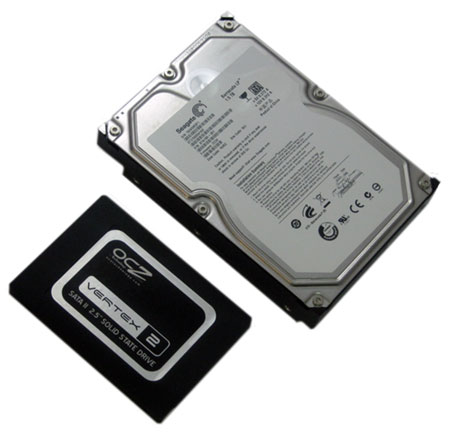
So, the user connects the new 1.5TB hard drive Seagate Barracuda LP to the MSI Z68A-GD80 motherboard (B3), runs the HD Tune utility and gets the following result.

Not a bad result, but no more. Wanting to improve it, the user collects a disk subsystem within the framework of Intel RST SSD Caching technology.

Go ahead, show this user how to properly configure the Intel Rapid Storage Technology utility.
Before us is the working window of the Intel Rapid Storage Technology hard disk management utility. In the “Storage System View” field you can find a mention of the drives installed in the system.
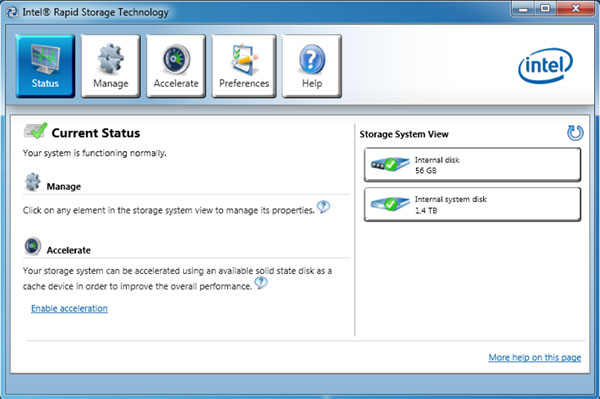
Go to the tab "Acclerate" and select the item "Enable Accleration".
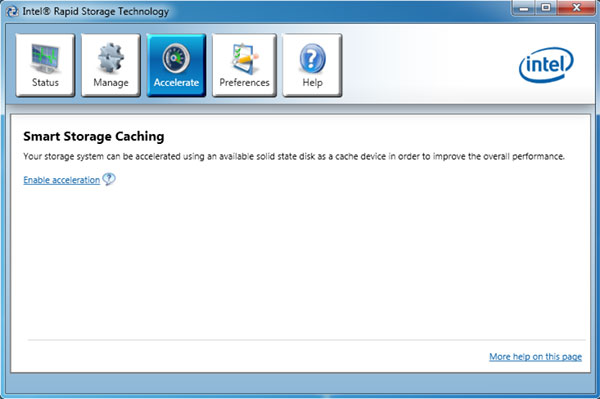
In the appeared window, click "Ok" and wait ...
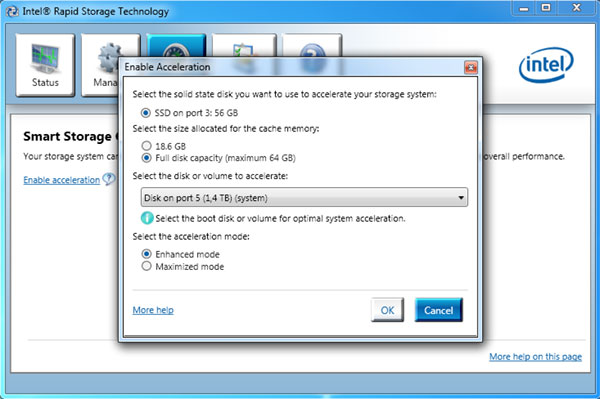
... in about a minute (on the system in question, 52 seconds)
get system notification.
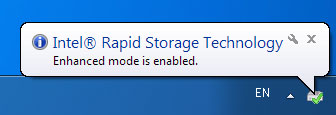
Everything is done correctly and the drive OCZ Vertex 2 is now used as a cache for the hard drive Seagate Barracuda LP. Go to testing.

The result of all the mess with the setting should be the same - the result. Three programs will help us see the work of Intel Rapid Storage Technology in numbers - HD Tune, HDM benchmark from PCMark 2005 and HDM benchmark from PCMark 7. I would like to remind you that you need to run the tests two or three times.
HD Tune
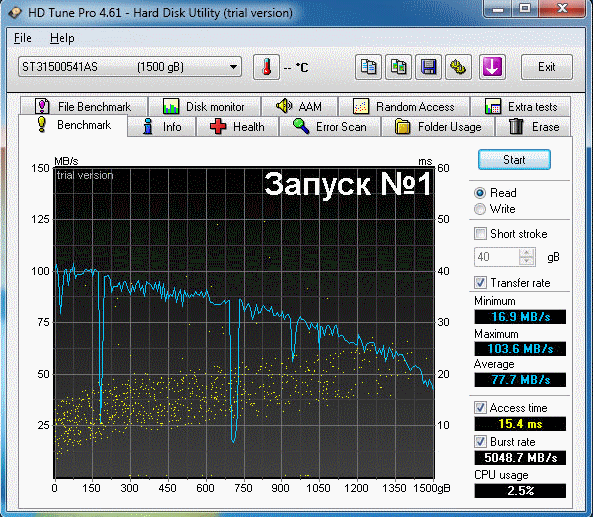
Already after the restart, it is possible to get almost twice the performance gain of the PC disk subsystem.
PCMark 2005
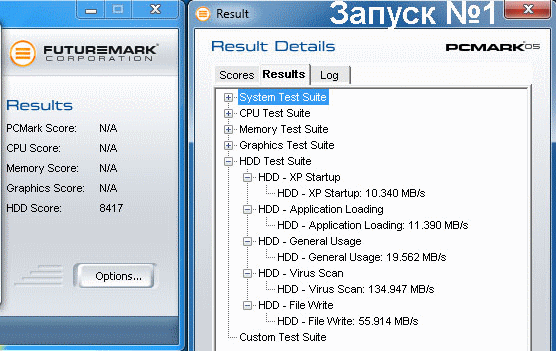
Without undue modesty, we can say a threefold increase in the “parrots” in the HDM test in PCMark 2005. In practice, it is enough to restart the application so that the data is processed by the Intel Rapid Storage echnology driver and placed in the OCZ Vertex 2.
PCMark 7
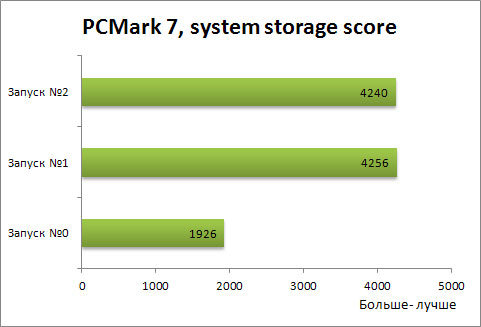
Zero start should be understood as testing without activating Intel Rapid Storage Technology. The PCMark 7 benchmark runs the HDD tests three times before giving the final result, which means it’s enough to run it once. Again, I would like to note the performance gain of the disk subsystem by more than 100%.
Conclusion
First of all about acquaintance with LucidLogix Virtu and Intel RST SSD
Caching
LucidLogix Virtu - the advantage of the Intel Quick Sync Video hardware block and the computational power of a discrete graphics card in one bottle. Technology from the company LucidLogix should be neglected only last. Thanks to the virtual driver Lucid Multi GPU, the entire stage of switching between embedded and discrete graphics remains completely transparent to the user. The only thing that the user will notice when starting a game or a benchmark is the cooling system of a discrete video card: it will be heard. In addition, do not forget about energy savings, because in 2D mode, discrete graphics will work at minimum frequencies.
The Intel RST SSD Caching solution is also interesting. Engineers and programmers of the processor giant have created a very useful tool to speed up the PC disk subsystem. Once everything is set up, the applications that the user launches each time will load much faster. Useful technology RST SSD Caching and gamers, who often use commands Save / Load.
The MSI Z68A-GD80 (B3) motherboard pleased with a certain cohesion of everything that MSI engineers put into it. When communicating with it, there is a feeling of a certain integrity. Pleases set of delivery, PCB design, overclocking capabilities, the presence of a graphical user interface UEFI Setup to control the BIOS settings. The level of pleasure from owning a Z68A-GD80 (B3) is enhanced after becoming acquainted with all its technologies, and in particular with LucidLogix Virtu and Intel RST SSD Caching. The motherboard almost perfectly fit into the view of most users about what is important in the motherboard based on Intel Z68 Express, and what is not. The MSI Z68A-GD80 (B3) motherboard will not be able to disappoint, it simply has no prerequisites for that.
Source: https://habr.com/ru/post/124890/
All Articles